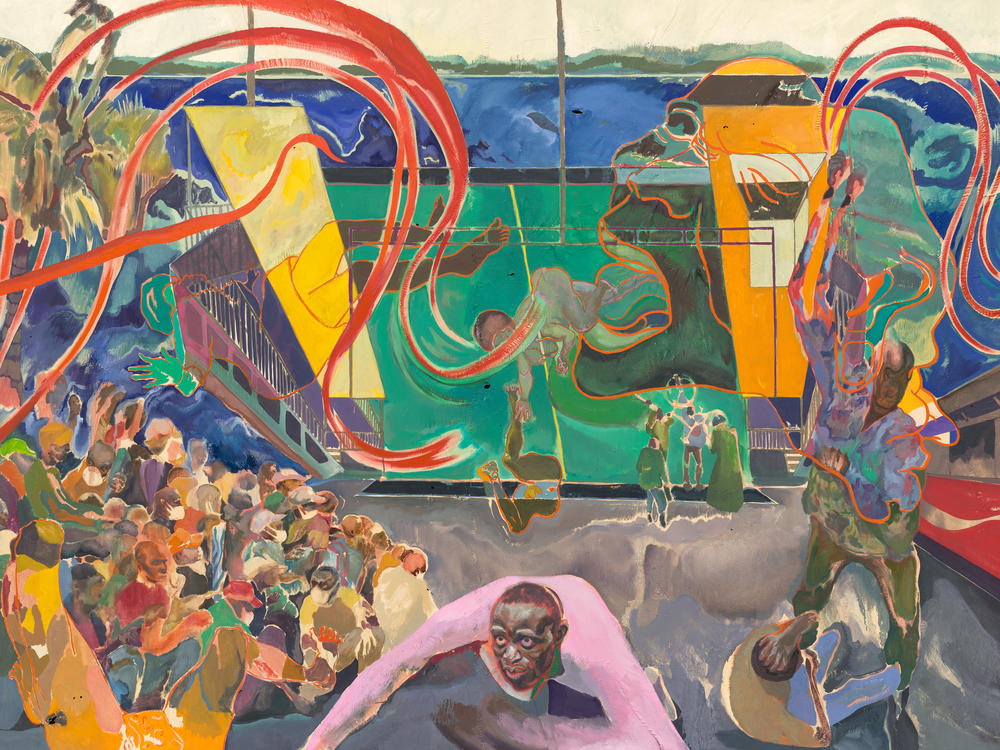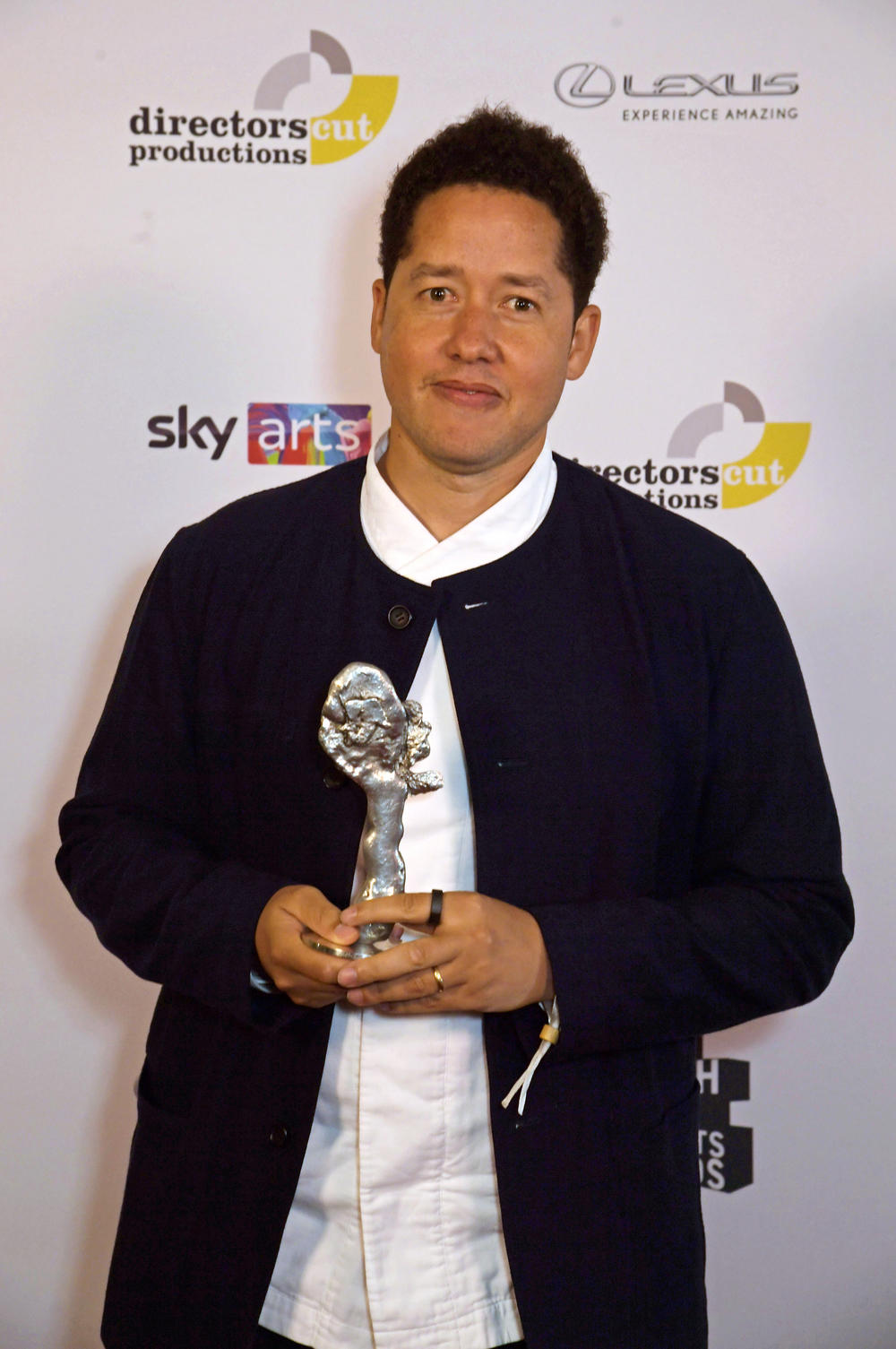Section Branding
Header Content
A 'modern masterpiece' paints pandemic chaos on cloth made of fig-tree bark
Primary Content
The painting is as dazzling as it is unsettling, not only by virtue of its monumental size (8' 2 1/2" x 11' 5 7/8") but also its boisterous colors and panoramic view of figures in motion. As your gaze goes from left to right, you see a mass of people, many in white face masks, surging forward; bodies and angry faces hurtling through the air; an enraged, open-mouthed, disembodied face; reddish coral-colored whorls that look like angry, bloody whips.
What is going on here?
Kenyan-British artist Michael Armitage painted Curfew (Likoni March 27, 2020) while moving between Nairobi and London during the COVID-19 pandemic. The work is a response to an incident in the port city of Mombasa, Kenya, when passengers, unable to board severely overcrowded ferries in time to meet a government-imposed curfew, were beaten and tear-gassed by paramilitary police. According to curator Ugochukwu-Smooth C. Nzewi of the Museum of Modern Art, where the work now hangs, it is nothing less than "an apocalyptic foreboding that transcends the specific event in Mombasa to reflect the global upheaval and uncertainty of the pandemic moment."
Born in Nairobi in 1984, Armitage studied at the Slade School of Fine Art and the Royal Academy Schools in London. His work is known for its diverse influences from African art, Western art and current political and social events. Armitage paints on lubugo cloth, which is made from fig-tree bark, in part to ground his work in East African history. His widely acclaimed work has been exhibited in museums and galleries in Europe, Africa, Australia and the United States. In 2020 he founded the non-profit Nairobi Contemporary Art Institute (NCAI) to promote contemporary art from East Africa and opened an exhibition space in Nairobi. NPR interviewed Armitage via email to find out more about his work. The interview has been condensed for clarity and space.
What is the story behind your painting, Curfew?
Curfew was made over a two-year period. [It] depict[s] a moment of trauma. On the first day of the first curfew that the Kenyan government put in place to restrict movement of people and help stem the spread of COVID-19, workers traveling back home from work were caught out at a ferry crossing. The curfew meant the number of people trying to use the ferry was unusually high, too high for the capacity of the ferries. Hundreds of people were waiting to get a ferry and did not make it home in time for the curfew. The police at the Likoni ferry crossing started "punishing" the commuters for breaking the curfew. Police made the commuters squat or lie on the ground, then many of them were whipped or beaten as they waited for a ferry to take them home.
Is there a message or meaning that you would like observers to take away from this painting?
My paintings are open to interpretation but often I am interested in telling the stories of people who don't get the chance to have their stories told.
fair outcome.
Washington Post art critic Sebastian Smee described Curfew as "a modern masterpiece." What have been the reactions to the painting?
From what people have said to me, the painting takes a little time to unravel and is a little disorienting at first, but it is a painting that gives people more, the more time they spend with it.
In this work, as in all your work now, you use lugubo, bark cloth. How and why did you choose to use this material? What special qualities does it bring to your work?
I was looking for a material that would locate the paintings' subjects in East Africa. I had been experimenting for a couple years before I came across some place mats and coasters made out of bark cloth, what I would later find to be lubugo bark cloth.
Lubugo bark cloth is made by the Baganda people and sourced from the bark of the mutuba tree. Lubugo translates to English as "funerary shroud" and this is its primary use.
I became even more interested in the cloth as this repurposing for the tourism trade – and total loss of cultural meaning – seemed to echo much of the changes and pressures on traditional cultures as the region evolves.
In the past when I had tried to experiment with alternatives to canvas I frequently came into the issue of the material being too physically or visually prominent where it could potentially come across as overly affected. The surface would dominate the painting. While there are characteristics to lubugo which dictate the composition of the paintings – for example, the naturally occurring holes, coarse stitching and how the mark sits on the cloth – lubugo performs much like a canvas and when stretched and painted on [by the artist], the unexpected elements of the cloth and its history are integrated in the painting and are not immediately obvious upon first glance. This made the subversive material elements of the painting much more subtle.
Diane Cole writes for many publications, including The Wall Street Journal and The Washington Post. She is the author of the memoir After Great Pain: A New Life Emerges. Her website is DianeJoyceCole.com.
Copyright 2023 NPR. To see more, visit https://www.npr.org.


